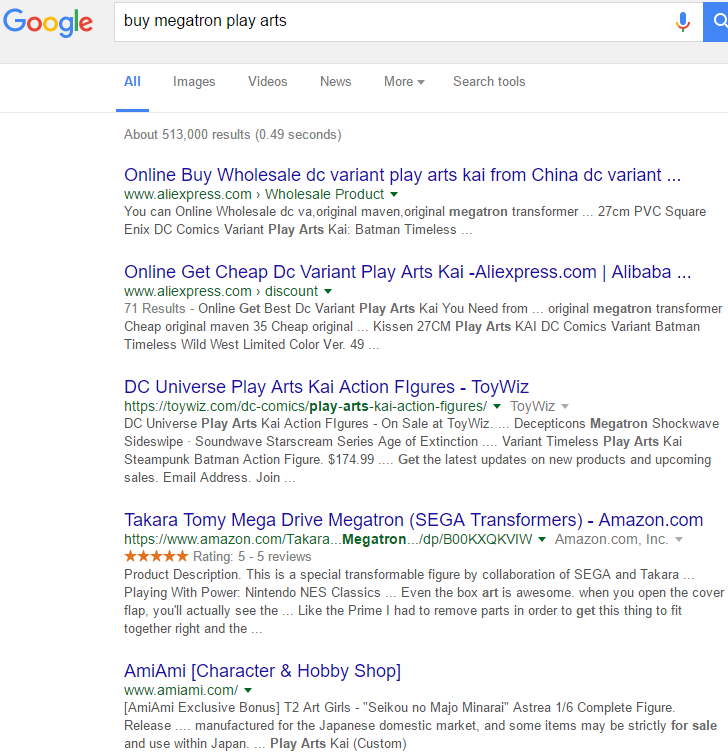Ah, search engine optimization. I have a strong love-hate relationship with the artform. I’m certain its true for anyone who has the will to dabble in the arcane craft of SEO.
Alas! SEO for eCommerce websites is even more complicated and mystical than traditional SEO. In the everlasting quest for the holy grail of Google’s first result ranking, many throw our hands up in despair and resign from the task altogether. Some persist doggedly, adamant that SEO “must-be-done”.
Fewer still go about it in a practical & time efficient manner, tackling the problem with a mixture logic and creativity, never actually enjoying it.
Of course, InstanteStore comes with a built in “SEO Wizard” to help you take care of the back-end and technical aspects of SEO, like Schema implentation. There are still practices that you should undertake to build upon that foundation.
I’ve been studying a whole bunch of eCommerce websites, so I’m sharing several good and bad trends I’ve noticed among merchants in 2016. The craft may seem mysterious in theory, but practically, the execution is often straightforward.
What Search Engines Want
The most common issue I notice when browsing shopping websites is the amount of duplicated content. This usually stems from having multiple product pages for variations of the same item. Fix it by making sure all variations (size, colour, material) are on the same product page and displayed via drop-downs or radio buttons. We know search engines are contemptuous of duplicate content, providing zero value to audiences. So let’s make this a forbidden practice. The tech exists for this fix, hence a technological obstacle is no excuse for it.

An even weaker version of the duplicate content affliction is copy pasting supplier product descriptions, often to the point where many merchants have the same exact copy. I’m glad to report that it’s not something I notice much anymore, but it does happen so I’m just letting you know: this is sooo forbidden, there should be a wall of “NOPE” around it. If your products suffer from contentimus duplicatitis, do whatever it takes to make it original. Hire a copywriter if you must to make sure your product pages don’t contain copy that anyone else has.
It’s not efficient to create unique copy for thousands of product pages though. Instead, using your web analytics tool (you have one right?), pick your most popular product pages for original content.
What People Want
Another problem I often encounter is the worrying lack of search query optimization. Unless you sell iPads or a popular product, don’t use product names as your search indicator. Instead target the product type: tablets, insect repellent, autumn chrysanthemum arrangements, Halloween cookies, etc.
Think about what the shopper is searching for-what they actually type into search engines when they begin their digital journey. This will help determine the kind of language used to reach your pages. So if your insect repellent is called “Bugone”, maybe people will be more likely to find it if you optimized for the search term: “bug spray”, or “insect repellant”.

Search engines (and people too) love it when a page matches the users intent exactly. It’s logical. So if a page matches a shopper persona, it should show up when a person in searching for information. If a page matches a buyer persona, it should be listed when the person is ready for product options.
#Winning 2016
Atop a meadow of clouds, perched firmly at the top of SERPS is Polyvore. It’s a fashion shopping site, where they know their audience well and the social tech they favour. They have thus given shoppers the ability to create bundles of products, making up their own styles that they can upload so other users can browse and shop. Users can also interact with other bundles and share them across social media.

I’m pleased to say that I’ve noticed an increase in merchants opting for user generated content. This is great for SEO because it means older indexed pages are regularly updated, letting search engines know that your pages still have activity and thus are still relevant. Up till recently, user generated content was mostly in the form of user reviews and testimonials. As companies like Polyvore show us, there’s more than one way to skin this dragon!
User generated content is beneficial in several ways:
- Your community will contribute content of their own, cutting down a chuck of your workload. A community interaction is a healthy one.
As mentioned above, new content keeps your pages refreshed and indicates activity to search engine bots. It’s why online forums do well at SEO.
The community your create benefits from it as well because they get recognition for putting together popular outfit ensembles, creating an enjoyable user experience.
J!NX clothing give their shoppers the ability to post pictures of themselves with their new loot, and earn rewards for it too:

A quick and simple fix for user generated content is to add social media feeds to your most popular pages. This is a good strategy if you don’t have much engagement on your site but have a responsive audience on your social media channels.
*Remember that people want to engage with brands they see, so don’t hold back. On social media you should be tagging your posts with relevant people, and make use of those #tags to get your content in front even people who would otherwise not be able to see your content.
Which brings us to…
Social Media Marketing. SEO is no longer confined to making search engines like your pages and content. It’s now more important to make your content visible (and popular) on different channels on the web, because people who engage with your content are indicting to search engines that your content is relevant. Hence the more people engage with it, the more priority search engines will give it.

It’s the reason you’ll see outdated content on the first page of many results, because it was once the most popular result for a search, and nothing new has come along that is as popular, even if there are more relevant contemporary piece available.
These channels include the various social media platforms like Facebook, Instagram, Twitter, Youtube (yes!) as well as community forums.
In the past, back-links used to hold a lot of weight in SEO ranking, so much that internet marketers hacked the system and created lots of artificial links a ranking boost. Given enough effort a page could rank number 1 on Google with a day or two. Naturally this led to a poor experience for the user, and so things aren’t as simple anymore.
So my suggestion is this: the next time you are on Facebook, spend a few minutes to join a group relevant to your market and promote your own content with a link and a few words about it. I’m not even talking about a blog post-though it can be. I’m talking about a specific product. I say start promoting a product you personally use because it will help word your promotional post in a fluid and genuine manner. Use that as practice before writing about products you aren’t as passionate about and springboard yourself into a natural rhythm.

If you do this for a single piece of content on multiple groups, across various social networks, you will start to get in front of many eyeballs. That’s a great first step. Once your foundation is solid, audience engagement will be an easier obstacle to demolish. If you can only spare time to promote one piece of content to one group, once a week, that is infinitely more than getting zero social signals. So do it for as long as you can before losing yourself to the void…
The key to tying social media with SEO is the user engagement. The goal is to have lots of people sharing your content over a short period of time, which is the “virality” factor that a social media marketer so intensely craves. It isn’t necessary to go all Ice Bucket Challenge every single time. What works in the long run is the cumulative effects of content promotion.

As with anything digital, always be tracking and analysis your traffic, your search terms and your rankings. Figure out what’s working and replicate the process from there. A methodological process will ensure you start getting results faster.
And that’s all folks!
As you can gather, social interaction has a significant role in contemporary SEO, although many traditional tactics do still carry weight. It’s all about the ratio of importance the engines assign to each ranking factor.
Doing SEO by bolstering my social media marketing efforts works well for me. It covers all my priorities: achieving KPI goals, what I have time for, and what I enjoy. Try something yourself and see what works best for you based on what you can manage to get done.
Mastering SEO isn’t for everyone, but it doesn’t mean only the most seasoned practitioners are capable of conjuring clever spells. You’ll see that most of the time you’ll be getting incremental results over long periods of time. Once in awhile, stars align and magic wills itself into being without much help, resulting in a massive surge of traffic, engagement and popularity. It’s an incredible rush to see it happen before your eyes as weeks and months of work pay off all at once!






